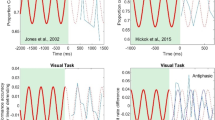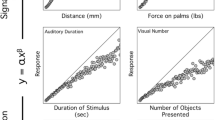Abstract
Conditioned suppression and stimulus tracking techniques were combined to yield a psychophysical threshold within each discrete stimulus trial. The flicker rate of a visual stimulus progressively decelerated throughout a 20-sec trial terminated by shock, with flicker fusion threshold defined as the flicker rate at the initiation of conditioned suppression of key pecking. Within-trial flicker fusion thresholds were determined for 10 different monochromatic stimuli at each of three radiometric intensities. The resulting thresholds defined radiometric equivalence functions (equal energy contours) and photometric equivalence functions (equal brightness contours) which are consistent with the reported photopic spectral sensitivity of the pigeon. The results suggest that stimulus continua may be programmed as conventional static stimuli to generate stimulus-controlled differential response patterns with each discrete trial.
Similar content being viewed by others
Reference Note
GEORGE, H. W. A comparison of two methods for determination of flicker fusion thresholds. Unpublished master’s thesis, Tulane University, 1968.
References
ANOKHIN, P. K. 1958. The role of the orienting-exploratory reflex in the formation of the conditioned reflex. In L. G. Voronin, A. N. Leontiev, A. R. Luria, E. N. Sokolov, & O. S. Vinogradova (Eds.), Orienting reflex and exploratory behavior. Moscow: Academy of Pedagogical Sciences.
BLOUGH, D. S. 1957. Spectral sensitivity in the pigeon. Journal of the Optical Society of America, 47, 827–833.
BLOUGH, P. M., RIGGS, L. A., & SHAFER, K. L. 1972. Photopic spectral sensitivity determined electroretinographically for the pigeon eye. Vision Research, 12, 477–485.
BOWMAKER, J. K. 1977. The visual pigments, oil droplets and spectral sensitivity of the pigeon. Vision Research, 17, 1129–1138.
BRADY, J. V. 1971. Emotion revisited. Journal of Psychiatric Research, 8, 363–384.
BRADY, J. V., & HUNT, H. F. 1955. An experimental approach to the analysis of emotional behavior. Journal of Psychology, 40, 313–325.
BYKOV, V. D. 1958. On the dynamics of the orienting-exploratory reaction during the formation of positive and inhibitory conditioned reflexes and their alterations. In L.G. Voronin, A.N. Leontiev, A.R. Luria, E.N. Sokolov, & O.S. Vinogradova (Eds.), Orienting reflex and exploratory behavior. Moscow: Academy of Pedagogical Sciences.
FLESHLER, M., & HOFFMAN, H. S. 1962. A progression for generating variable-interval schedules. Journal of the Experimental Analysis of Behavior, 5, 529–530.
GOVARDOVSKII, V. I., & ZUEVA, L. V. 1977. Visual pigments of chicken and pigeon. Vision Research, 17, 537–543.
GRAF, V. 1969. A spectral luminosity function in the pigeon determined by flicker photometry. Psychonomic Science, 17, 282–283.
HENDRICKS, J. 1966. Flicker thresholds as determined by a modified conditioned suppression procedure. Journal of the Experimental Analysis of Behavior, 9, 501–506.
HENTON, W. W. 1972. Avoidance response rates during a pre-food stimulus in monkeys. Journal of the Experimental Analysis of Behavior, 17, 269–275.
HENTON, W. W., & BRADY, J. V. 1970. Operant acceleration during a pre-reward stimulus. Journal of the Experimental A nalysis of Behavior, 13, 205–211.
HENTON, W. W., & IVERSEN, I. H. 1978. Classical conditioning and operant conditioning: A response pattern analysis. New York: Springer-Verlag.
HENTON, W. W., MONAHAN, J. C., & ELLINGSON, O. L. 1980. Another psychophysical procedure: Within-trial thresholds. Physiology and Behavior, 25, 945–952.
HENTON, W. W., & SPOHN, W. D. 1980. Classical conditioning with compound unconditioned stimuli. The Psychological Record, 30, 47–60.
IKEDA, H. 1965. The spectral sensitivity of the pigeon (Columbia livid). Vision Research, 5, 19–36.
IVERSEN, I. H. 1975a. Reciprocal response interactions in concurrent variable-interval and discrete-trial fixed-ratio schedules. Scandanavian Journal of Psychology, 16, 280–284.
IVERSEN, I. H. 1975b. Concurrent responses during multiple schedules in rats. Scandanavian Journal of Psychology, 16, 49–54.
IVERSEN, I. H. 1975c. Interactions between lever pressing and collateral drinking during VI with limited hold, The Psychological Record, 25, 47–50.
IVERSEN, I. H. 1976. Interactions between reinforced responses and collateral responses. The Psychological Record, 26, 399–413.
KANTOR, J. R. 1959. Interbehavioralpsychology. Bloomington, Indiana: Principia Press.
PASTERNAK, T. 1977. Delayed matching performance after visual Wulst lesions in pigeons. Journal of Comparative and Physiological Psychology, 91, 472–484.
POWELL, R. W. 1967. The pulse-to-cycle fraction as a determinant of critical flicker fusion in the pigeon. The Psychological Record, 17, 151–160.
POWELL, R. W., & SMITH, J. C. 1968. Critical-flicker-fusion thresholds as a function of very small pulse-to-cycle fractions. The Psychological Record, 18, 35–40.
RAND, J. F. 1977. Behaviors observed during S in a simple discrimination learning task. Journal of the Experimental Analysis of Behavior, 27, 103–117.
RAY, R. D. 1977. Psychological experiments as interbehavioral systems: A case study from the Soviet Union. The Psychological Record, 27, 279–306.
RAY, R. D., & BROWN, D. A. 1975. A systems approach to behavior. The Psychological Record, 25, 459–478.
RAY, R. D., & BROWN, D. A. 1976. The behavioral specificity of stimulation: A systems approach to procedural distinctions of classical and instrumental conditioning. Pavlovian Journal of Biological Science, 11, 3–23.
ROSENBERGER, P. B. 1970. Response-adjusting stimulus intensity. In W. C. Stebbins (Ed.), Animal psychophysics: The design and conduct of sensory experiments. New York: Appleton-Century-Crofts.
SILBERBERG, A., HAMILTON, B., ZIRIAX, J. M., & CASEY, J. 1978. The structure of choice. Journal of Experimental Psychology: Animal Behavior Processes, 4, 368–398.
SIDMAN, M., RAY, B. A., SIDMAN, R. L., & KLINGER, J. 1966. Hearing and vision in neurological mutant mice. Experimental Neurology, 16, 377–402.
SMITH, J. C. 1970. Conditioned suppression as an animal psychophysical technique. In W. C. Stebbins (Ed.), Animal psychophysics: The design and conduct of sensory experiments. New York: Appleton-Century-Crofts.
ST ADDON, J. E. R. 1969. Multiple fixed-interval schedules: Transient contrast and temporal inhibition. Journal of the Experimental Analysis of Behavior, 12, 583–590.
STADDON, J. E. R. 1970. Temporal effects of reinforcement: A negative “frustration” effect. Learning and Motivation, 1, 227–247.
STADDON, J. E. R. 1977. Schedule-induced behavior. In W. K. Honig & J. E. R. Staddon (Eds.), Handbook of operant behavior. Englewood Cliffs, New Jersey: Prentice-Hall.
STADDON, J. E. R., & SIMMELHAG, V. L. 1971. The “superstition” experiment: A reexamination of its implications for the principles of adaptive behavior. Psychological Review. 78, 3–43.
STEBBINS, W. C. (Ed.). 1970. Animal psychophysics: The design and conduct of sensory experiments. New York: Appleton-Century-Crofts.
Author information
Authors and Affiliations
Rights and permissions
About this article
Cite this article
Henton, W.W., Ellingson, O.L. & Edwards, W.P. Within-Trial Psychophysics and Stimulus Control: Radiometric and Photometric Equivalence Functions for the Pigeon. Psychol Rec 31, 63–75 (1981). https://doi.org/10.1007/BF03394721
Published:
Issue Date:
DOI: https://doi.org/10.1007/BF03394721




